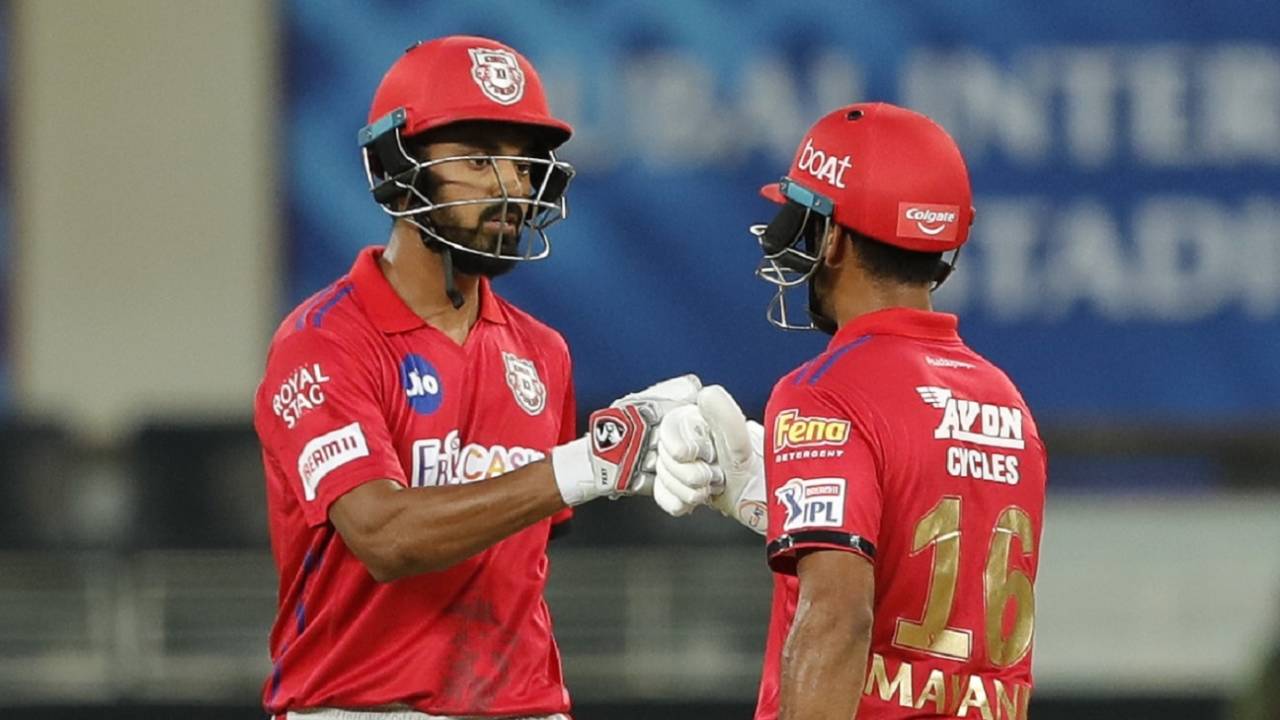Are big partnerships overrated in T20 cricket?
IPL numbers suggest longer stands are becoming less relevant in high-scoring matches
Shiva Jayaraman
28-Sep-2020
Data from the IPL suggests that it's dangerous for one batsman in a long partnership to simply give the other batsman the strike • BCCI
We probably wouldn't be discussing this if Rajasthan Royals hadn't pulled off a heist against Kings XI Punjab in Sharjah. But why did KL Rahul, who is fully equipped to go ballistic like the other batsmen in the match, choose to play within himself and simply turn the strike over to Mayank Agarwal? Surely Kings XI could have done with the extra runs they could have put on the board had their captain scored at the pace he's capable of?
In a match where the other batsmen struck at almost 200, Rahul made a 54-ball 69 at a strike rate of 127.77. ESPNcricinfo's Smart Stats gave Rahul a negative value impact for his innings. It wasn't that he was rusty coming off the long break like some other top India batsmen have been in the league so far. After all, in Kings XI's previous match in Dubai, a bigger ground than Sharjah, he had put bowlers to the sword with an unbeaten 69-ball 132.

ESPNcricinfo Ltd
Steven Smith played a similar role in Royals' first match of the season in Sharjah, against Chennai Super Kings, playing second fiddle to a marauding Sanju Samson. Smith showed with a 27-ball 50 against Kings XI that he can score quickly if he chooses to. So why did the two batsmen, who are capable of scoring at the frenetic pace T20 cricket demands from them, play the strike-rotation game?
One possible reason could be that they are hard-wired to think in terms of partnerships, which are valued dearly in the longer formats. Coaches and experts, who have played much of their cricket in the longer formats themselves, perhaps share this philosophy too. Team think-tanks might worry about one wicket triggering a collapse, or new batsmen taking too much time to settle, even on flat surfaces.
Moreover, teams batting first possibly start their innings with the aim of putting up a score that is par for the prevailing pitch and conditions. Batsmen who are otherwise capable of hitting sixes might settle for giving the strike to their partners - the designated hitters in the partnership - as long as the team is on course to achieve that par score. Big partnerships where one batsman is going hard while the other is rotating the strike well are assumed to be good for the team's cause in all conditions.

ESPNcricinfo Ltd
The numbers suggest teams are happy for partnerships to follow that model. Data from 94 partnerships in the IPL where both batsmen have contributed at least 50 runs to the stand suggest that it's rare for both batsmen to play to their striking potential. Only three times in such partnerships have both batsmen scored at a 200-plus strike rate. Both batsmen have struck at 150-plus in only in 36 (38.2%) of the 94 stands, and as many as 58 (62%) of the stands had at least one batsman striking at less than 150.
The bat-first numbers are more significant here, since scoring rates in chases are dictated by targets. Out of the 58 partnerships where both batsmen have contributed 50-plus while batting first, 33 have come with at least one of the batsmen striking at less than 150. Nineteen of these 33 partnerships have come in losses.
The numbers are more revealing since the 2015 IPL season - a time of increased scoring rates overall - with only four out of 14 such partnerships coming in wins. In contrast, nine out of 13 partnerships where both batsmen went at above 150 have come in wins. These numbers show that partnerships where one batsman scores slowly leave teams vulnerable to not putting up a big enough total while batting first.
The T20 batting landscape is changing rapidly. Good chasing teams now have the confidence to go after targets however big they are. Data from the IPL indicates that a higher percentage of century stands in the first innings (even without the condition that both batsmen contribute at least 50) are coming in losses than they used to. Since the 2018 season, 12 of the 20 century stands that have come while batting first have come in losses. This means 60% of such partnerships have contributed to defeat. In the first four years of the IPL, only eight of the 33 bat-first century stands had come in losses. That's a swing of 47%. It's clear then that teams shouldn't look to build partnerships just for the sake of it.
Shiva Jayaraman is a senior stats analyst at ESPNcricinfo @shiva_cricinfo
